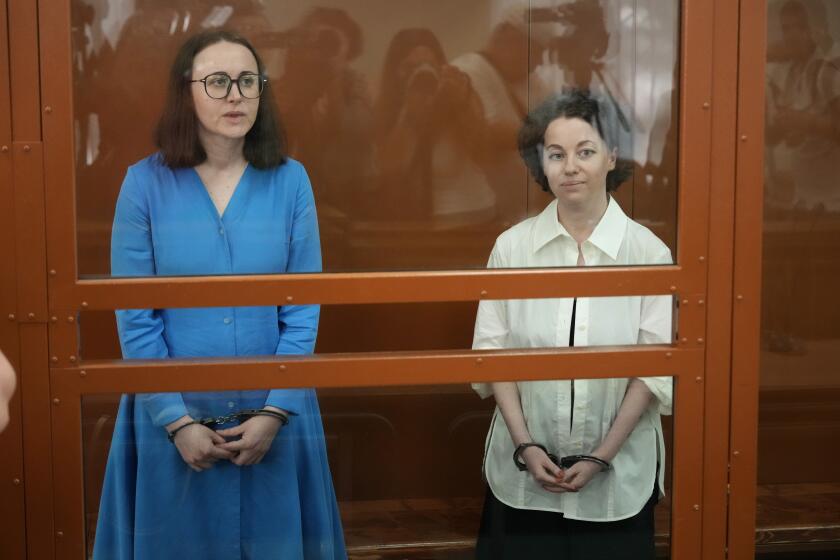Lives Recovered
Just after they move into the dorm room for their freshman year, just when they have landed their first full-time job, or just as they are mulling over the engagement proposal, their world caves in.
For the 100,000 people each year who are found to have schizophrenia--the onset usually in the late teens for men and early 20s for women--the disease begins to warp reality at a time when most young adults are drawing up ambitious blueprints for the future.
Despite what is shaping up to be a decade of startling progress in the development of new drugs to treat the disease, the road back from the horrors of schizophrenia remains tough indeed.
“The illness hits during that bridge between adolescence and adulthood when people are deciding what to do with their lives,” says Martha Sherwood of the Mental Health Assn. of Los Angeles County. “People need help in finding a way out of the illness in order to deal with the loss and start over.”
The fact that thousands of people with schizophrenia are making steady, if not spectacular, recoveries, say mental health experts, is due not only to sophisticated new medications but to the very commitment of helping patients “start over.”
This vigorous rehabilitation concept--called re-integration--is altering the view of schizophrenia, from a hopeless disease to one that can be lived with and successfully managed.
“Patients are getting better at rates we never dreamed were possible 10 years ago,” says Kim Littrell, founder of the Schizophrenia Treatment and Rehabilitation centers in Decatur, Ga., Indianapolis and Orlando, Fla. “There are five drugs we expect to be approved between now and the turn of the century. That’s seven new antipsychotics in the ‘90s, whereas we hadn’t had any new antipsychotics in 20 years. . . . But part of the problem is we need to make sure we have the ancillary services.”
Indeed, dishing out meds is the easy part, says Dr. Jerry Vaccaro, director of community psychiatry at UCLA.
As thousands of people with schizophrenia rekindle their ability to return to jobs, school or independent living, mental health experts across the nation bemoan the dearth of re-integration services to help these now cogent-thinking patients reassemble their shattered lives.
The barriers include the cost of rehabilitative services--vocational as well as social skills training; the lack of supportive people in their lives; and a society that still wrongheadedly regards mental illness as a personal weakness.
“It’s like a schizophrenic being locked in the house and medication unlocks the door. But you need someone to take you outside and show you around,” says Littrell. “I don’t ever remember a patient taking an [antipsychotic] medication and saying, ‘Good God, I’m a mess. Get me to Supercuts. And I need a job application.’ ”
*
Vicki Bentley’s life began to change last March when her psychiatrist handed her a tablet of the antipsychotic medication Risperdal.
For a dozen years, the Dayton, Ohio, woman had struggled with schizo-affective disorder, a variation of schizophrenia that includes mood disturbances.
A brilliant woman with degrees in mathematics and music, Bentley showed a dogged determination to get well and was moderately successful with the help of a caring doctor at the local Veterans Administration hospital and weekly visits with a therapist. She lived on her own and even founded a Schizophrenics Anonymous group in her area to force herself and others out of their isolation.
“I got better over time because I got to see my therapist every week,” says Bentley, 40, who had tried numerous medications. “But I had a dramatic improvement in my thinking ability when they started me on Risperdal last March.
“The Risperdal was like coming out of a fog. You take it, and it’s like you are coming out of a dark church into a bright, crystal-clear morning and the sun is beaming. Now, I can see. Now, I can understand. Now, I can think.”
Now, however, Bentley faces the huge question of what to do with the rest of her life.
“I have to get back into the real world,” she says. “I haven’t figured out a way to do that, but I’m working on it.”
Bentley remembers the real world--and how cruel it can be.
An ROTC recruit, she graduated from Miami University in Oxford, Ohio, with a music degree and entered the U.S. Air Force. But, in her early 20s, while working as an air traffic controller for the Air Force, Bentley says, she was sexually harassed by a superior. Her mental health began to deteriorate, she suffered a crushing breakdown and eventually was found to have schizophrenia.
Over 12 years, Bentley improved slowly and managed to pursue studies in applied statistics and engineering. She auditioned and won a spot in a local symphony orchestra playing violin.
Eventually, she tried to get a job.
“I guess people could tell something was wrong with me because no one would hire me,” she says. “[Prospective employers] would say that I have trouble with people. I had already decided in my mind that I can’t make it in the real world. I’m scared.”
Today, with her thoughts in order and her motivation surging, Bentley is trying to challenge that damaging self-assumption. She acknowledges that she hides behind her college textbooks; she is at work on yet another degree--this one in engineering--at Wright State University, supporting herself on a disability benefit.
“My real joy in life is learning. My parents say I’m a professional student,” says Bentley, who laughs, then pauses for several seconds.
“Maybe I am afraid,” she says finally, softly. “We [schizophrenics] are scared to go out in the real world. We’re afraid people will cut us down. We’re afraid they’ll fire us.”
*
One percent of Americans have schizophrenia, an affliction that medical journals routinely refer to as “the worst disease affecting mankind.”
Unique in its ability to torment and terrorize its victims, schizophrenia causes people to hear threatening voices, see horrifying images and find the umbilical cord between their thoughts and their feelings bloodlessly severed. “Cure” is a word that is never associated with the disease, and, until recently, even getting better was considered a fragile benchmark.
Since the 1970s, antipsychotic drugs such as Haldol and Thorazine have laid to rest some of the demonic aspects of the disease--the voices and delusions that are technically known as the positive symptoms. But these medications fail to help at least one-third of all schizophrenics and have no effect on the so-called negative symptoms: lack of motivation, social withdrawal, blunted emotions, difficulty expressing oneself.
“With the older antipsychotics, an ‘improved outcome’ was not being in the hospital,” says Dr. Gary Tollefson, vice president of central nervous system research at Eli Lilly, which has a new medication, olanzapine, awaiting FDA approval.
Traditional antipsychotics also frequently cause a side effect called tardive dyskinesia, which causes muscles to stiffen, impairing movement. That leads some people to give up medication, says Tollefson. One study of the older drugs, from the National Institutes of Health, showed that half of all patients relapse within a year of their initial hospitalization and 85% within five years. More than one-third attempt suicide.
The new generation of drugs, however, aims to treat both the positive and negative symptoms of the disease without the debilitating side effects.
Since 1990, Clozaril and Risperdal have been approved by the Food and Drug Administration, and two more highly touted medications are awaiting probable FDA approval this year.
Moreover, no fewer than four other medications for schizophrenia are well into research protocols and show enormous promise, according to experts.
“We are talking about a real breakthrough experience for many, many people,” says Laurie Flynn, director of the National Alliance for the Mentally Ill and the mother of a daughter with schizophrenia. “The newer drugs help people to manage their lives. . . . They don’t produce side effects; consequently, people are taking them. And compliance has been critical with schizophrenics.”
The first of the new drugs, Clozaril, can produce a rare blood disorder. Because of this complication, the medication is generally reserved for patients who have failed to improve on the other antipsychotics.
Risperdal represented a first-line treatment, and the drugs awaiting FDA approval--olanzapine and Abbott Laboratories’ sertindole--are first-line therapies as well, in that doctors can prescribe them immediately upon diagnosis.
The choice of several new first-line therapies is expected to be a boon in treatment, Flynn says, “because we never know which agent is going to help an individual. The more choices we have, the more we’ll see large numbers of people moving back into society.”
Clearly, the wealth of new antipsychotics has whetted a big appetite for full recovery, experts say.
“We find that the more we educate people about the new medications, the more in demand they are,” says UCLA’s Vaccaro. “When people find out that they can do something about Johnny-- that he can do more than sit there all day in front of the TV smoking cigarettes--they want that.”
And so do many of those who have long suffered.
*
Ray Lacey, 49, typifies schizophrenics who plunge off the edge and survive to discover that the road to recovery extends only part way back.
Dating his illness back to a “wacky” childhood, the Washington, D.C., man earned college and medical degrees despite struggling with mental illness. After clawing his way into a medical residency in Chicago, where he was put in charge of an intensive care unit, Lacey experienced a crippling breakdown.
A combination of traditional medications and a period of calm has allowed Lacey to get a peek at normalcy. (There is some evidence that schizophrenics naturally stabilize in their 40s and 50s after turbulent years in their 20s and 30s.) He now has an apartment and a roommate and works in an office filling book orders.
But, Lacey says, “It’s hard to say I like filling book orders when I was in a medical residency and ran an intensive care unit. I still feel like I’m off on the sidelines.”
He is desperate to try Risperdal, but he can’t afford it and neither can the public health clinic where he receives treatment. (Clozaril and Risperdal both cost about $2,500 per year. The newer drugs are also expected to carry high price tags, and insurance coverage is spotty.)
But with glowing appraisals attached to the new generation of antipsychotics may come the mistaken belief that a patient’s transformation will be quick and painless.
For most people who get better--and certainly not all do--recovery is tediously slow, marked by small setbacks and dependent on a broad band of supportive people.
Eli Lilly’s Tollefson says drug makers worry that the newer medications may be administered without the other half of the prescription--re-integration services. He points out that studies of olanzapine show that as many as half of all patients taking the drug improved enough to be candidates for re-integration.
But, he says: “Unless there are appropriate services, I think that families could become frustrated.”
A combination of medication and re-integration services offers schizophrenics the best hope of a full recovery, says Dr. Mark Ragins, a community psychiatrist at the Village Integrated Service Agency in Long Beach, a program operated by the Mental Health Assn. of Los Angeles County.
“The two things have to be offered at the same time,” he says. “Whether or not someone takes their medication, for example, depends incredibly on your relationship with them.”
For example, with the clarity of thinking that often accompanies drug therapy, many schizophrenics begin to recognize that they have lost the precious years when their peers were claiming their independence and their adulthood.
“We see an intense mourning over what they have missed,” says Village Integrated director Martha Long.
The program is a unique pilot project devoted to helping adults with serious mental illness live, learn, socialize and work in the real world. It provides everything from medical services to job and money management training to opportunities to socialize. And it operates its own minimart, cafe and bank to give its members life experience.
“I think we in mental health often perceive our job wrong,” Ragins says. “I think our job is to help people live in the community. Money management, for example, is an integral part of living in the community. It has nothing to do with treatment.”
Founded in 1990, 95 of Village Integrated’s initial 120 clients have remained with the program. The walls inside the old brick structure near downtown Long Beach feature framed photos of clients who are enrolled in school or have landed jobs. Employing a philosophy that emphasizes success over failure, the clients are called “members” and staff are called “coaches.”
“We try to set a culture here of ‘You can get a life,’ ” says Long. “That’s why those pictures are on the wall.”
Alan Anderson is a member who has worked hard for his place on the wall and in society. Found to have schizophrenia at 16, he spent a dozen years in a board-and-care facility fearing all the while that he would never live independently or hold a job.
Now 40, Anderson is enrolled in three classes at Long Beach City College, lives in an apartment and helps plan social events at Village Integrated. He says he feels like a graduate of the program, but doesn’t want to sever his ties there because of the chronic nature of his disease. He tried school last year but dropped out, overwhelmed by the stress.
“With mental illness there are setbacks, you know?” says Anderson. “Whether you are ready for the outside world sometimes has a lot to do with self-esteem.”
*
Studies that document the effectiveness of re-integration services are stacking up, including two reports in the January issue of the journal Psychiatric Services that show a high success rate when Clozaril is paired with rehabilitation.
And in a study she recently presented, Littrell found that 60% of the schizophrenics, when receiving Risperdal and re-integration services, returned to school or a job or had engaged in some type of external social activity within six months.
Re-integration services, however, are scarce and costly.
“There is recognition that these programs are important, but we haven’t seen the commitment of funds,” says Flynn of the National Alliance for the Mentally Ill.
Village Integrated operates as a capitated funding system; that is, it receives a set amount of money for each member and is responsible for providing or purchasing all the services the member needs. The system works because very few of its members require costly hospitalizations.
Nevertheless, the staff increasingly faces the dilemma of whether to start members on the expensive new medications or use the money for psychosocial services, Ragins says.
It’s arguable whether the new medications or a more sophisticated approach to rehabilitation has done more for turning schizophrenia from a dead-end disease into a chronic, manageable one.
“We’ve had this explosion in our knowledge about the brain,” says Vaccaro. “But, in a similar way, our knowledge about rehabilitation has grown so much. We know, for example, that certain types of family interventions can halve people’s relapse rates and alter the course of the illness.”
Vaccaro says he recently scrapped a 5-year-old lecture on schizophrenia that he routinely presented to medical students. When he looked at his slides, he found the lecture terribly outdated “about unemployment rates and all the things schizophrenics can’t do.”
For example, when Vaccaro’s patient John, who asked that his last name not be published, was hospitalized for the first time in 1993, he began “goal planning” before he even left the hospital. Now on Risperdal, he is studying to be a doctor.
“It wasn’t that I had to relearn skills,” John, 25, says of his brief incapacitation. “I had to become a part of society again. I had to start classes again, enroll as a volunteer at the [school] laboratory, join my church choir again.
“My doctor telling me I could do it was a big help. I guess the biggest obstacle is my own belief in myself--that I can be re-integrated and that I have the skills within myself.”
More to Read
Start your day right
Sign up for Essential California for news, features and recommendations from the L.A. Times and beyond in your inbox six days a week.
You may occasionally receive promotional content from the Los Angeles Times.






